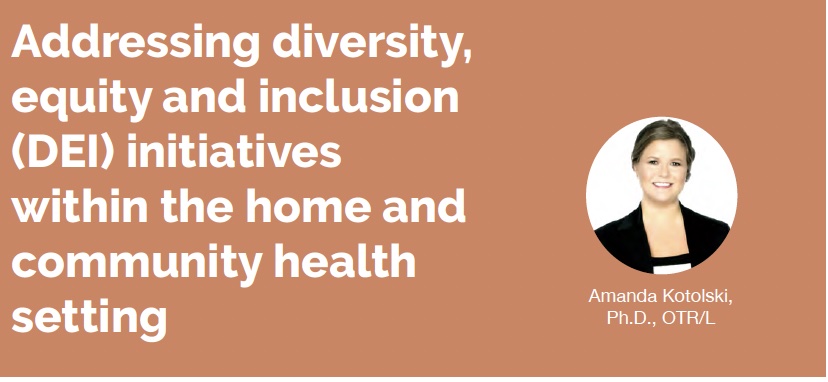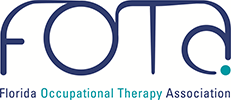Addressing diversity, equity and inclusion (DEI) initiatives within the home and community health setting

The American Occupational Therapy Association’s (AOTA’s) Vision 2025 conveys a strong commitment to diversity, equity, and inclusion (2020a). It is everyone’s right to feel welcomed, valued, included, and respected while engaging in daily life regardless of each of our own unique abilities and challenges. This statement made by AOTA supports efforts to increase diversity, equity, and inclusion (DEI) within all aspects of occupational therapy, including practice, education, and research, as well as policy development and advocacy (AOTA, 2020a). Therapist’s working in the home and community setting provides important client-centered services of which DEI principles implicitly embrace.
- Diversity: “Diversity includes all the ways in which people differ, and it encompasses all the different characteristics that make one individual or group different from another. It is all-inclusive and recognizes everyone and every group as part of the diversity that should be valued” (Racial Equity Tools, 2020, para. 1). Diversity has vastly expanded from its original race, ethnicity, and gender categories to include numerous internal, external, organizational and world views perspectives. Internal influence also includes but is not limited to age, sexual orientation and physical and mental ability. Education, interests, spirituality, and religion are incorporated as external influences. While job function, work location, and department fall under organizational influences. World views involve cultural events, politics, and history knowledge (AOTA, 2022). Applying and executing diversity allows for everyone to learn and connect from one another by providing several ideas, perspectives and values.
- Equity: Equity is an approach that ensures everyone is given an equal opportunity; meaning that resources may be divided and shared unequally to make sure that each person can access an opportunity. However, equity and equality mistakenly get interchanged. While necessary resources may be provided to all equally it is equity that considers people have different access to these resources because of a system of oppression and privilege (AOTA, 2020a). Equity seeks to balance this disparity. Having an equitable versus equal system allows communities to collaborate, have increased positive outcomes and build a strong foundation (AOTA, 2022).
- Inclusion: “Inclusion is the acceptance and support of diversity wherein the uniqueness of beliefs, values, and attributes is welcomed, valued, and leveraged for maximum engagement” (Taff & Blash, 2017). This provides the safe space for collective differences and diverse backgrounds to be included, respected, and valued (AOTA, 2022). Mallery (2018) proposes that when people, organizations, and the world begin implementing DEI principles, one should remember to ask three questions. 1) Diversity: Who is in the room? 2) Equity: Who is trying to get into the room and can’t?, and 3) Inclusion: Has everyone been included and has everyone’s ideas been heard? The American Psychological Association (2021b) has published a DEI inclusive language guideline which provides the latest updates to bias free terminology.
As occupational therapy practitioners, the most effective way to assist and implement DEI principles is through advocacy. We are able to accomplish this through multiple methods: sharing, empathy, encouragement, listening, recognition and assessment of biases. Sharing of resources, information learned through professional development and opportunities within our profession for leadership. Showing of empathy to clients and communities we work with regarding racial trauma. Encouraging others, clients and coworkers to speak up and take on leadership roles within their community and organizations. Always listen and be mindful of others’ experiences. Recognize and normalize speaking out against discriminatory practices and systemic inequities. Continue to assess and identify unconscious biases. Harvard has created Project Implicit, which gives free access to fifteen assessments regarding biases that were developed for “understanding disparities in so many aspects of society, including but not limited to health care, policing, and education, as well as organizational practices like hiring and promotion” (Project Implicit, 2011, para. 2).
Diversity, equity and inclusion principles and practice are also stated within our occupational therapy practice framework. Occupational justice refers to the right of all individuals to participate and have equity in occupational choice to increase their well- being (AOTA, 2020b). Cultural competency was a widely accepted term used in occupational therapy to describe the ability to understand and effectively interact with people of all cultures. However, use of this term proved problematic in that no one really can assume competence with regard to culture, which is rich in variability and complexity. The term cultural competence has gradually been replaced with cultural relevance, cultural sensitivity, and other similar terms. It is the hope all healthcare practitioners, including occupational therapists, will use cultural humility as an approach that emphasizes humble and empathetic communication with clients, with reduced reliance on bias or implicit assumptions.
With increased diversity comes opportunities for increased cultural differences, more diverse languages spoken, and more varied forms of occupational participation. Recent studies have shown that racial and ethnic minorities make up 38.1% of the population in the United States and this number is projected to grow to 52% by 2055 (Office of Disease Prevention and Health Promotion, 2020). In addition, the U.S. Census Bureau (2018) reported that 85.3 million Americans, or 27.2%, live with a disability which is the largest minority population (Office of Disease Prevention and Health Promotion, 2020; APA, 2021b). Home and community-based providers can be great advocates for the clients we work with who are interested and would benefit from participating in the workforce. The U.S. Department of Labor is providing incentive to employers and businesses to increase job opportunities for people diagnosed with a disability. Through education and advocacy for diversity, employers can gain the capacity to appreciate and value individuals since disabilities are a natural part of diversity. The U.S. Department of Labor has published campaigns and materials for businesses to recruit, hire and retain employees who identify as having a disability: apprenticeships, internships, how to create an inclusive workforce, and employer assistance programs to help offset funds when starting and recruiting employees with disabilities (2022).
Please like our Facebook HCH SIS page: www. facebook.com/FOTAHomeandCommunityHealthSIS/
References
American Occupational Therapy Association [AOTA]. (2020a). Occupational therapy’s commitment to diversity, equity, and inclusion. American Journal of Occupational Therapy, 74(Suppl. 3), 7413410030. https://doi.org/10.5014/ajot.2020.74S3002.
American Occupational Therapy Association [AOTA]. (2020b). Occupational therapy practice framework: Domain and process (4th ed.). American Occupational Therapy Association, 74(Suppl. 2), 7412410010. https://doi.org/10.5014/ajot.2020.74S2001
American Occupational Therapy Association. (2021). AOTA’s guide to addressing the impact of racial discrimination, stigma, and implicit bias on provision of services. https://www.aota.org/ practice/practice-essentials/dei
American Occupational Therapy Association. (2022). DEI toolkit. https://www.aota.org/practice/practice-essentials/dei/diversity- equity--inclusion-toolkit-learning-modules
American Psychological Association. (2021a). Framework. https:// www.apa.org/about/apa/equity-diversity-inclusion/framework.pdf
American Psychological Association. (2021b). Inclusive language guidelines. https://www.apa.org/about/apa/equity-diversity- inclusion
Mallery, T. (2018). Diversity, equity and inclusion: Explained. Diverse City Labs. https://diversecitylabs.com/blog/diversity- equity-and-inclusion-explained
Office of Disease Prevention and Health Promotion. (2022). Discrimination. Healthy People 2020. https://www.healthypeople. gov/2020/topics-objectives/topic/social-determinants-health/ interventions-resources/discrimination
Project Implicit. (2011). What is implicit bias? https://www. projectimplicit.net/
Racial Equity Tools. (2020). Racial Equity Tools glossary. https:// www.racialequitytools.org/glossary
Taff, S. D., & Blash., D. (2017). Diversity and inclusion in occupational therapy: Where we are, where we must go. Occupational Therapy in Health Care, 31(1), 72-83. doi:10.1080/0 7380577.2016.1270479
United States Department of Labor. (2022). Diversity and inclusion. https://www.dol.gov/agencies/odep/program-areas/ employers/diversity-inclusion
